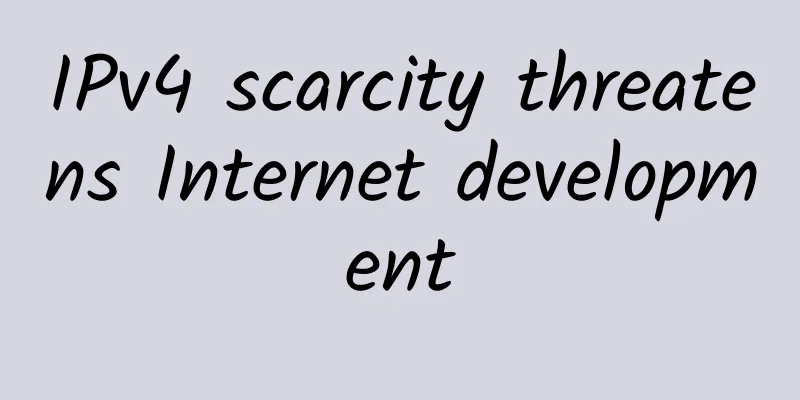IPv4 scarcity threatens Internet development

|
RIPENCC, the regional internet registry for Europe, the Middle East and Central Asia, announced in October that it expects the world to run out of IPv4 addresses in about a month. This makes the deployment of IPv6, the successor to IPv4, the only way to ensure the long-term growth of the global Internet. Although RIPENCC has stated that it will continue to recover IPv4 addresses after they are exhausted, it expects to receive hundreds of thousands of IPv4 addresses each year, but it is still far from enough compared to the millions of IPv4 addresses that network operators need. IPv4 exhaustion will make life more difficult for networks because they will be forced to introduce more complex and expensive workarounds to cope with the shortage of addresses.
However, the IPv4 address exhaustion issue does provide an opportunity for the global Internet to take a hard look at future plans based on networks to secure their current IP resources and ensure they become part of a global project for large-scale IPv6 deployment. Challenging times RIPENCC reached the final allocation of IPv4 addresses from IANA seven years ago. This event triggered a policy change that the technical community had prepared in advance - the organization changed to only handing out small portions of addresses, aiming for a one network and one whole approach. But now, even this small amount of addresses, which has helped to curb some of the effects of IPv4 scarcity since 2012, will be exhausted. Of course, this was also long expected, and the global Internet will continue to operate normally after it is exhausted. But for many networks, the lack of available IPv4 addresses is a serious problem. One-third of 4,000 network operators surveyed earlier this year said IPv4 exhaustion was one of the main challenges facing their companies, while just over half of respondents (54%) said they would need more addresses in the coming years. Not being able to obtain IPv4 addresses means that networks will have a hard time scaling effectively to accommodate future growth. To ensure their network issues are properly addressed, many companies today find they need to resort to complex, expensive and time-consuming workarounds. Some networks have sought to acquire addresses by trading on the “IPv4 transit market.” The market quickly took off after the 2012 announcement of IPv4 exhaustion, and today could mean more bang for the buck for those that get involved. In many cases, the market has given networks some breathing room in acquiring much-needed addresses, albeit with a hefty price tag attached. But IPv4 is ultimately a finite resource, and if price increases are anything to go by, most of the easily accessible addresses may already have been sold. Another strategy to mitigate IPv4 scarcity is Carrier-Grade Network Address Translation (CGNAT). CGNAT allows a single public IP address to be shared between multiple customers (in some cases, thousands of users may be behind the same address). However, this can be problematic. CGNAT doesn't scale forever, which increases the complexity of the network - which means there's a greater chance of failure. When CGNAT fails, thousands of users can be affected. CGNAT is expensive, and many services that require end-to-end connectivity (such as video conferencing, online gaming, or business sharing tools) can't be used with it. Break free from constraints Workarounds can extend the limited number of addresses further, but in the long run, they are not suitable for IPv6. Although IPv4 is still the main protocol, it has been stretched to its limits. Internet companies have managed to connect about 4.5 billion users and billions of other devices with only 4.2 billion IPv4 addresses. IPv6, on the other hand, contains 340 trillion addresses, which opens up huge possibilities for better network configuration, efficiency and innovation. While the benefits of IPv6 seem clear, taking action is not so simple. Many network operators have spent their entire careers working with IPv4, and IPv6 may seem unfamiliar in comparison. There are many different pieces of hardware and software in a network, all of which need to be tested and potentially updated to work with IPv6. While RIPENCC and other RIRs offer IPv6 training, many network operators are focused on more pressing issues and are happy to catch up when they see real progress in deployment. But while they weren’t paying attention, the movement may have already started. Back in 2012, less than one percent of users worldwide accessed Google over IPv6. Today, that number is around 25%. But the really interesting results are at a country level. According to APNIC, around 66% of Internet users in India and 50% of Internet users in the United States have IPv6 enabled, while most OECD countries have IPv6 enablement rates between 20% and 35%. If you convert these percentages into actual Internet users, you’re talking about billions of users who already access the Internet over IPv6 today. One can hope that this latest IPv4 exhaustion milestone will help further emphasize the need for IPv6 deployment. Of course, there is still some distance to go before we can realistically talk about shutting down the IPv4 internet (which will likely come in some form). But what is clear is that sticking with IPv4 will become increasingly costly, increasingly constrain growth, and reflect the short-term thinking of many network operators. Ultimately, IPv6 is the only way forward if we want to continue to expand the internet and further develop the digital economy. |
<<: Thoroughly understand Cookie, Session, Token
Recommend
After 5G entered the market, the driving effect began to emerge
On September 21, the three major operators releas...
Novos: €8/month KVM-2GB/40G NVMe+1TB/25TB/Belgium
According to information from LEB, Novos.be is a ...
The latest Redis unauthorized access vulnerability, how to protect Redis security?
Redis is an open source, network-based, memory-ba...
"Feng Qingyang" Jack Ma will "retire" and look back at the 20 years of China's Internet trends
The wind disappears, but the tide moves. Septembe...
Happy New Year!
The rat has gone and the ox has come, bringing ne...
Apple iPhone is required to shut down 2G network due to too many loopholes: Android has already done it in advance
The GSM 2G network has been around for more than ...
Getting started with SD-WAN, just read this article
In 2019, the global market for SD-WAN grew by 70%...
Build telecom-grade WiFi and lay out the entrance to the wireless city?
As early as 2013, the WiFi networks of the three ...
Yunnan Telecom will gradually shut down its 3G network starting June 1
Yunnan Telecom recently issued an announcement st...
SD-WAN Today and Tomorrow
[[429002]] Traditional network technology faces e...
What is 5G RedCap, and can it save cellular IoT?
Regardless, in theory the latest version of the 5...
Huawei launches new smart security brand Huawei HoloSens, leading the smart security market
Dongguan, China, August 8, 2019 - At the "In...
Unlimited mobile data packages are criticized: "Unlimited" is very big, and "Speed limit" is hard to find
Since the three major operators launched unlimite...
Using DDC to build AI networks? This may just be a beautiful illusion
ChatGPT, AIGC, big models... a series of dazzling...
Maxthon Hosting: 56 yuan/month KVM-2GB/40GB/400GB/Korea CN2, Hong Kong CN2, Japan, US CN2, etc.
Aoyozhuji, a long-established foreign VPS service...









